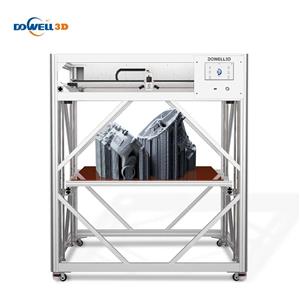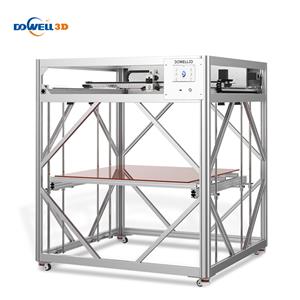What are the obvious advantages and disadvantages of 3D printing?
1. The finished product is fast
Fast, efficient, and low-cost printer 3d large size printing and injection molding processes have replaced time-consuming and expensive manufacturing techniques. Now, new developers can get an injection molding quotation and know the cost of bringing a new product to market almost immediately. Injection molding is a cost-competitive technology for manufacturing a large number of identical plastic parts. Once a mold is created and the machine is set up, other parts can be manufactured very quickly and at low cost.
2. Accurate and diverse configuration
3D plastic printing can easily manufacture complex shapes, many of which cannot be generated by any other manufacturing method. No matter how complex the shape is, product design and manufacturing can be completed using 3D printer large industrial printing technology. It has outstanding advantages in the manufacturing of precision parts such as airplanes and automobiles.
3. No need for machining
3D printing technology does not require machining or any molds, and can directly generate parts of any shape from computer graphics data. Doing so can greatly shorten the product development cycle, increase productivity, and reduce production costs. Compared with traditional technology, 3D printing technology reduces cost and material waste by abandoning production lines.
Fourth, product customization
3D industrial printer can not only provide greater design freedom, but also completely custom designs. Since the current 3D printing technology can only manufacture a small number of parts at a time, it is very suitable for small batch customized production. The customized concept has been accepted in the fields of medicine, dentistry, orthopedics and other fields, and is used to produce customized prostheses, implants and orthodontic appliances. From tailor-made advanced sports equipment and running shoes that are perfect for athletes to custom sunglasses and earrings, 3D printing can cost-effectively produce customized parts at once.
Of course, 3D printing has not only advantages, but also disadvantages. The following points are the disadvantages in the application of 3D printing technology. With the advancement of technology and the acquisition of corresponding research results, these conditions are expected to be improved in the future.
1. The printing effect is limited by the material
Although high-end industries can print on plastics, certain metals or ceramics, the materials that cannot be printed at present are relatively expensive and scarce. From the perspective of the entire industry, the stability and ease of use of materials still need to be improved, and the bottleneck faced by the research and development of new materials is difficult to achieve a breakthrough in a short time. In addition, some 3D printing equipment has not reached a mature level and cannot support various materials that people come into contact with in daily life.
2. Whether the finished product is sturdy and durable
Houses and cars can be "printed", but can they withstand wind and rain, and can they run smoothly on the road? 3D printing is currently more commonly used polymer materials, and each material has its own melting point and various properties such as fluids. It is difficult for 3D printing to match the current materials, resulting in the shortcomings of the printed product being brittle.
3. Concerns about intellectual property
Nowadays, with the gradual strengthening of legal awareness, people are paying more and more attention to the protection of intellectual property rights in the music, film, and television industries, and 3D printing technology will also involve this issue. How to ensure that the 3D printed products have legitimate copyrights and are free from misappropriation and fraudulent use has become a problem that must be solved in the development of the industry. How relevant departments formulate 3D printing related laws and regulations to protect 3D printing intellectual property rights is also the key to whether 3D printing can be used reasonably.
4. Difficult to overcome environmental factors
In the 3D printing room, usually due to insufficient air purification, gaps in the machine, and impurities mixed in metal powder materials, the oxygen content in the printing room will change differently, which will also have an adverse effect on the mechanical properties of the printed parts. , It may even cause the chemical composition in the parts to change, so finding a way to detect the oxygen content in the printing room is one of the important measures.





